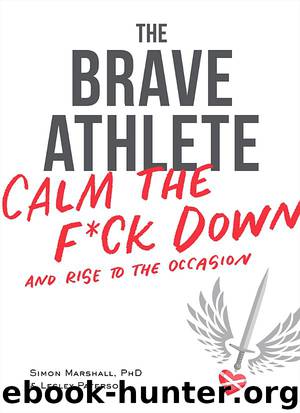The Brave Athlete by Simon Marshall & Lesley Paterson

Author:Simon Marshall & Lesley Paterson
Language: eng
Format: epub
ISBN: 9781937716912
Publisher: VeloPress
Published: 2017-05-10T04:00:00+00:00
Gremlin 8: Failing to do things that make you feel good
There are plenty of reasons why treating yourself to something pleasurable is a good idea when you’re feeling down in the dumps. In psychological terms, this is called a “lifestyle buffer” because it’s not necessarily related to the stressor itself (the injury), but it helps mediate the stress response caused by it. Lifestyle buffers can take many forms, but we prefer ones that help to micro-dose dopamine and serotonin, the brain’s feel-good neurotransmitters. You know it as treating yourself.
What you can do about it: One of the best rewards for an injured body and a depressed brain is massage. The nice kind. Most endurance athletes do not need to be sold on the benefits of regular massage. The physiological, circulatory, and musculoskeletal benefits are so well accepted that most athletes would submit their bodies to the kneading and digging every week if money permitted. That said, and as most athletes will attest, a sports massage is rarely a spa-like experience that rains down pleasure. Deep-tissue massage can be an eye-welling, sweat-inducing pummeling. When athletes are injured, routine massages often fall by the wayside because the thought of getting finger punched for 60 minutes isn’t that appealing. However, a grossly undervalued benefit of massage is its efficacy as psychological therapy. Classical or gentle massage (i.e., not the teeth-clenching, punchy kind) causes a surge in oxytocin that reduces anxiety and pain perception. Massage causes brain neurochemistry to change so you feel better emotionally. After massage, dopamine is up 31 percent and serotonin 28 percent, and the stress hormone cortisol drops.15 Simply put, massage is brain therapy for the injured athlete. So when you’re feeling especially crappy, schedule a massage. The gentler kind. Screw the body; this one’s for your head.
When nothing seems to help.
Some injuries never really leave you, physically or emotionally. They can end careers, change your life outlook, or just make you miserable for years on end. What’s more, an injury or illness experience might be so impervious to the strategies discussed in this chapter that no matter what you do, nothing seems to help. If you find yourself dealing with an injury that has left such strong emotional or physical scars, then a useful place to start is learning how to repair and rebuild self-schema and identity. Languishing with a victim mentality (“Why me?” or “Life is so unfair”) might feel entirely justified to your Chimp brain but does little to restore psychological well-being in the long term. Finding a new normal (the survivor mindset) takes courage and honest reflection, but, most of all, homework. After all, it’s hard to have to work out who you are again and to develop the mindset and confidence that a new identity needs to survive and thrive. Start by reading Chapter 2 to learn about the building blocks of self-schema (the thoughts you have about yourself) that create the scaffolding for a strong, vibrant new identity. It’s far from a solution, but it’s the right place to begin.
Download
This site does not store any files on its server. We only index and link to content provided by other sites. Please contact the content providers to delete copyright contents if any and email us, we'll remove relevant links or contents immediately.
Born to Run: by Christopher McDougall(7066)
Bodyweight Strength Training Anatomy by Bret Contreras(4614)
Dynamic Alignment Through Imagery by Eric Franklin(4119)
Men's Health Best by Men's Health Magazine(2551)
The Coregasm Workout by Debby Herbenick(2221)
Starting Strength by Rippetoe Mark(2079)
Relentless by Tim S Grover(2045)
Core Performance Essentials by Mark Verstegen(1982)
Endure by Alex Hutchinson(1967)
Bigger Faster Stronger by Greg Shepard(1946)
Weight Training by Thomas Baechle(1742)
Relentless: From Good to Great to Unstoppable by Tim S Grover(1652)
The Stretching Bible by Lexie Williamson(1557)
The Spartan Way by Joe De Sena(1535)
Practical Programming for Strength Training by Mark Rippetoe & Andy Baker(1531)
Good to Go by Christie Aschwanden(1447)
Dr. Jordan Metzl's Running Strong by Jordan Metzl(1383)
The Art of Throwing by Amante P. Marinas Sr(1355)
Total Hockey Training by Sean Skahan(1349)
